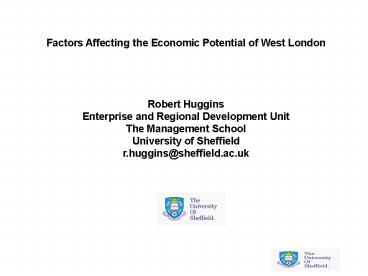Factors Affecting the Economic Potential of West London PowerPoint PPT Presentation
1 / 18
Title: Factors Affecting the Economic Potential of West London
1
Factors Affecting the Economic Potential of West
London Robert Huggins Enterprise and Regional
Development Unit The Management School University
of Sheffield r.huggins_at_sheffield.ac.uk
2
West London boroughs of Hammersmith and Fulham,
Hillingdon, Hounslow, Harrow, Brent and Ealing
3
West London - Some Perceived Strengths
- Heathrow - the worlds busiest international
airport - excellent export and import access
through its international connectivity. - A significant creative industries cluster,
embodied by the BBC studios and surrounding
audio-visual cluster in White City and Park
Royal. - West London is home to some of the biggest blue
chip organisations in the world, many of which
have their headquarters located there. These
include GlaxoSmithKline - Diageo - Cisco -
British Airways - IBM - BBC - United Biscuits -
BSkyB - Kodak - Bechtel - Carphone Warehouse. - A significant concentration of employment within
the transport and logistics sector, particularly
within air transport. - The main road and rail links to all parts of
Britain and particularly between central London
and the Thames Valley and the west of England. - Relatively strong skills base.
4
West London - Some Perceived Weaknesses
- West London lags behind the rest of London in
terms of per capita output approximately 9
lower. - A higher unemployment rate than the UK average
and relatively high levels of long-term
unemployment - over one in every four claimants
within Brent has been claiming benefit for one
year or more. - Business start-up rates in west London lag the
regional average by some way there has been a
large differential since the late 1990s. - Localities with significant multiple deprivation.
- West London is perceived to have suffered as a
result of East Londons development, which has
been boosted by the of the Docklands area and the
financial businesses on its western fringe.
5
Standard Deviation of Sub-Regional GDP per Capita
for UK Regions
6
(No Transcript)
7
(No Transcript)
8
(No Transcript)
9
Employment by Sector (as a proportion of total
employment)
10
Employment Growth (Compound Annual Growth Rate)
1998-2002
Source Annual Business Inquiry
11
(No Transcript)
12
(No Transcript)
13
Employment (as a proportion of total employment)
in selected service sectors
Source Annual Business Inquiry
14
15
Source SEEDA
16
West London Economic Structure
- West London is largely differentiated from other
neighbouring sub-regional economies due to its
high level of employment in transport and
communications, and the distribution, hotels
restaurants sector. - West London employs a small proportion of its
workforce (in comparison with neighbouring
sub-regions) within banking, finance and
insurance. - It also has a relatively small proportion of
employment in public sector activities, compared
with surrounding areas. - West London possesses a real strength in the
digital media sector. However, comparing west
London with the Thames Valley we find that there
is a considerable differential in IT and
communications sector (which includes software
development) employment. - West London is under-represented in comparison
with a number of its neighbours in the business
and management consultancy sector. Only north
London has a lower proportion of its employment
within this sector.
17
Growth Constraints
- Perhaps a key constraint to business growth in
west London is the apparent lack of economic
connectivity with neighbouring areas such as
Central London and the Thames Valley. - It has an obvious strength in the transport and
communications sectors, but lacks a critical mass
of other tradable specialisms in the
knowledge-based sectors (with the exception of
the creative industries). - Business start-up rates in west London lag the
regional average, and are not occurring in those
sectors that have a high growth potential. - There is little evidence that current business
support mechanisms are creating the level of
business growth required in west London,
particularly for high value-added businesses,
where market failures are often more difficult to
address.
18
Concluding Remarks
- In order to develop the west London economy, the
sub-region should also seek to integrate itself
more with its surrounding sub-regional economies. - Whilst the Thames Valley, Surrey, Buckinghamshire
and Central London have a large density of
knowledge-based employment, the same cannot be
said of west London which is wedged between
these sub-regions. - The proximity of central London, as well as its
proximity to the Thames Valley and other
high-performing South East England sub-regions,
means that West London is within the centre of
the UKs most competitive regions. - Given its location and transport links, west
London has an opportunity to capitalise upon the
opportunities on offer as a result of its
location by increasing interaction and acting as
a bridge between central London and the Thames
Valley.

